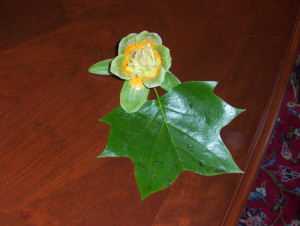Thomas Jefferson was President of the United States when he wrote, “Altho’ the times are big with political events, yet I shall say nothing on that or any subject but the innocent ones of botany and friendship.”
Jefferson kept to that resolution in the lengthy letter he posted to his friend and fellow garden enthusiast, Madame Noailles in 1803. In lieu of political commentary, he sent a long list of North American plants that he intended to ship to her in France. Among the listed plants was a favorite of his, Liriodendron tulipifera or tulip tree, which he grew at Monticello. Jefferson’s Garden Book shows that he also sent the plant to other horticulturally-minded friends in England and France.
Why did Jefferson refer to the tulip tree as “the Juno of our groves”? Probably because it grows tall and straight, reaching up to 200 feet in height. In a woodland setting, a collection of mature tulip trees is reminiscent of a group of massive columns reaching for the sky. Jefferson, with his love of classical architecture, probably felt instinctively drawn to the trees’ dramatic size and shape.
Poet Walt Whitman also felt inspired to describe the species’ majesty in classical terms, calling it “the Apollo of trees.”
Liriodendron tulipifera is a native American member of the magnolia family. Sometimes known as “yellow poplar”, “tulip poplar” or “canoewood”, the trees grow wild in the eastern half of the continent, frequenting moist woodland and hilly or mountainous areas.
The “tulip” nickname comes from the shape of the flowers, which appear in late spring or early summer. Upright and cup-shaped, they are a distinctive greenish-cream, with orange markings near each flower’s base. The unusual color and shape make these “tulips” unique among tree-borne flowers, but, because of the size of the trees, they are hard to see from the ground. The fallen ones are equally difficult to miss.
Honey and other bees gravitate to the flowers. I have never tasted tulip tree honey, but it is supposed to be relatively dark in color and strongly flavored.
To my eye, at least, the glossy green tulip tree leaves also have a floral connection, resembling the stylized tulips sometimes depicted on early American quilts. This connection is even more pronounced when the foliage turns bright yellow in the fall.
Like magnolias, tulip trees boast interesting fruits, which are long and cone-shaped. In the fall those cones are loaded with the dry, winged seeds that botanists call “samaras”. Once those seeds fall to the ground and germinate, young tulip trees develop quickly, growing up to three feet in one year. The flowers take their time, however, and sometimes don’t appear until the tree is 20 years old.
It is not surprising that this tallest of the eastern North American trees has been useful over the years. The wood has been made into furniture, implements and crates, while some Native American groups crafted canoes from the straight trunks and used the roots to make tonics and remedies for heart ailments. Taking a page from the indigenous peoples, frontiersman Daniel Boone reportedly transported his family down the Ohio River via a long canoe made of liriodendron wood.
Tulip trees have also provided artistic inspiration. In 1998, the United States Postal Service issued a liriodendron stamp as part of a series depicting native American trees.
Back in the days when streets were narrow and planting strips were wide, tulip trees were sometimes used as street trees. Now they are simply too big for most street-side plantings. That doesn’t mean that you can’t grow a tulip tree in a large lawn area. They are magnificent specimens for parks and other wide open spaces, which is why they are often found in arboretums and botanical gardens, not to mention rural cemeteries like the Mount Auburn Cemetery outside of Boston. The cemetery placement is very fitting, because once installed, the average tulip tree will preside over generations of human activity. The Jefferson-era trees at Monticello lasted into the twenty-first century, with the last one succumbing in 2008.
So, if you, like Thomas Jefferson, are weary of conversation about political events, seek out the tulip trees in your neighborhood, nearby parks and botanical institutions. Their majesty, longevity and history will give your soul a respite from the daily news.

